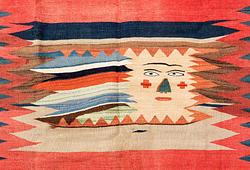Important Spring Sale presents Carl Edberg's Masterpiece
Carl Edberg's masterpiece
When Bukowskis presented a silvered and gilded brass chandelier at the spring auction in 1984, of the same type as the chandelier now being auctioned, it was the first time this model had attracted attention. The chandelier caused a sensation but also raised questions about where it was made. Its high quality led to the initial assumption that it was made in France. However, it soon became clear that the chandelier had to be Swedish, and that was the end of it. The questions surrounding these chandeliers have been many and the answers few, until now. Through his research, antiquarian Magnus Green has found the answers, which are now being presented here for the first time.
The chandelier offered at this auction, a masterpiece from Stockholm, has six branches and is lavishly decorated with rococo ornaments. It is cast in sand and composed of several parts that are alternately silvered and gilded. The parts of the central baluster, the shaft, are strung on a forged iron pin, the lower end of which is finished off by an elegant dragon with wings and a long tail, a popular motif with slightly Chinese characteristics in the 18th century. The dragon is not uncommon in the royal interiors associated with the Swedish architect Carl Hårleman. At the top, the softly cloverleaf-shaped loop is screwed to the iron pin, which ends in a small knob. The loop is decorated with a pair of dolphins with entwined tails. The pear-shaped globe is cast in two halves with an openwork asymmetrical decoration of leaves, flowers, rocailles, dragon wings and trellis patterns. It has an inner gilded globe in chased brass, also in two halves, which forms the background to this rich decoration in silver. A dense rococo decoration is repeated on the slightly twisted baluster-shaped shaft. The branches are S-shaped and decorated with lobed leaves. They supports lobed asymmetrical drip pans and asymmetrical leaf-ornamented nozzles. The small screws of the branches are attached, stuck down, to a round disc and fixed with small twisted decorative nuts. The chandelier also has a series of curved foliate ornamental arms with small screwed-on flowers. At the top of the chandelier is a half-naked putto, sitting on a small globe. One foot rests on a skull while he clutches a small bowl and is about to blow soap bubbles with a small tube.

n its general form, this is a Baroque chandelier. It also has a symbolism of the kind that the Baroque loved, the reminder of our mortality, in the form of the putto with its short-lived soap bubbles on the skull. In contrast, the rich ornamentation, characterized by sharpness and masterful chiseling, is fully developed Rococo. This is an excellent example of how French taste influenced Swedish craftsmen in the 18th century. A technical solution that is typical, and also French, is that the small screws of the branches are fixed with decorative nuts. This detail is found on a series of Swedish made chandeliers, both of silver and silver-plated brass, in the classic French Baroque style (compare a chandelier sold by Bukowskis, December 2021, A637, no 99).
A master identified
The chandelier now for sale is not signed, but through careful comparison with other chandeliers hanging in different Swedish churches, it has been possible to identify the chandelier maker. Like all the other preserved Swedish chandeliers (except one) that were masterpieces of the Stockholm Brass Founders, this one has a crowning figure in the form of a putto, a naked boy. Here he is blowing soap bubbles. On the other chandeliers, the crown figures have other attributes, different for each master's crown. The ability to vary freely in such details would have been part of the requirements for a good masterpiece. However, it is unlikely to have been a requirement of the churches that purchased a chandelier. A similar chandelier figure can be found on a brass chandelier with eight branches that a parish purchased in December 1762 for 400 daler copper coins. It was used for the first time at Christmas, when the church was to shine with light. According to the records, it was admired, and the parishioners were pleased with the purchase. Unlike the chandelier now on offer, this chandelier is signed on the globe, by the brass founder Carl Edberg. He became a master in Uppsala depending on Stockholm. In 1755, he became a burgess of Uppsala and soon acquired a workshop with both apprentices and journeymen. By the middle of the 18th century, he was the only active brass founder in Uppsala. He died in 1807 at the honorable age of 86. The inventory from the estate, dated the same year, lists tools that belonged to the workshop. What further indicates that the chandelier at the auction is made by Edberg is that the branches and ornamental arms are the same on both chandeliers. Based on comparisons with many other chandeliers, these would also have been unique to him. There are more documented chandeliers by Carl Edberg. One that was purchased by a parish in December 1768 by ‘Mr Carl Edberg in Upsala’ also has the same putto hugging a bowl. Another chandelier, acquired by a church in 1788, has the same figure as well as similar ornamental arms with flowers.
The guild system
From the Middle Ages until the 19th century, most urban craftsmen had to be affiliated to a guild, to be authorized to practice their trade. They started as apprentices at an early age and continued for several years until they could become journeymen. Then it was time to travel, often abroad, to improve their skills. Those who had become sufficiently skilled and were able to pay the associated fees could then try to become masters and thus be authorized to work independently in their guild. The requirements for one - or sometimes several - work samples, known as masterpieces, were often high. For the brass founders in Stockholm, this meant making a small brass chandelier with both silver plating and gilding without external help, which would then be examined and approved by the guild. These masterpieces could be the finest work produced by the craftsman in his lifetime. Technical skill and artistic flair were required throughout. Some of these masterpieces are preserved, mainly in churches or museums. Here we offer such a well-crafted and rare chandelier, of Swedish manufacture from the mid-18th century.
The Brass Founders in Stockholm
At the turn of the 18th century, a new guild was established in Sweden - “Gelbgjutarämbetet”, the Brass Founders Guild. The name comes from the German Gelbgießer, from ‘gelb’ for yellow, ‘Gießer’ for founder. The first Brass Founders were mainly German immigrants, and some surviving documents are written in German. They therefore did not differ significantly from their professional brethren on the continent. A guild was established in Stockholm at the beginning of the 18th century, but during the century, brass founders were established in many smaller towns. From the latter part of the 18th century onwards they were among the most important brass workers. Some of them were even engaged to carry out work for the royal palaces.
It is unclear when the brass foundry guild was established in Stockholm, as their minutes have not been preserved. The oldest texts, which are a protocol and quarterly book for the journeymen from 1705 to the 1760s, are written in both Swedish and German. In 1705, the alderman Master Johan Diedrich Geijer is mentioned, as well as the masters Sebastian (Bastian) Otter and Gottfrid Reman. The senior journeyman was Daniel Berendt, who is said to have arrived in Stockholm in 1703. Based on the journeymen's records, the guild should have been established by 1705 at the latest, possibly as early as 1702, since a preserved seal impression, which is rather indistinct, seems to show this year. The seal depicts a founder holding a smoking crucible by a long moulding tong. The inscription is illegible, but various objects are visible around the founder, including a snuffer and compasses. That snuffers were important to the brass founders is clear from the seal of Sebastian Otter, which includes one.
The Brass Founders made a variety of objects from brass or other yellow copper alloys. The term bronze is traditionally applied to many gilded works from the 18th and early 19th centuries, even when the copper has been alloyed with zinc. They cast in sand and made chandeliers, candlesticks, snuffers and book mounts and later also mortars, irons, weights, etc. The earliest we can associate with these craftsmen are the brass book mounts found on King Charles XII's Bible from 1703. The girdle makers, who also worked in brass, disliked the competition from the brass founders. Otherwise, there were many similarities with the work of the bell-, chandelier- and canon-founders, which explains the recurring disputes between them. Originally, the brass founders were only supposed to cast small objects in yellow coppar alloys, but this was abandoned, and the differences between them and the bell founders gradually disappeared. In 1821 a decree stated that the brass founders would be allowed to make everything that the bell founders made, with the exception of church bells. The latter were also to be allowed to make everything that the brass founders used to make. In the regulations on mastery that were introduced after the abolition of the guild system in the 1840s, the brass founders, girdle makers and bell founders were equated.
There were, however, several differences between the professions: brass founders like the girdle makers, had the right to use silver and gold plating, but only the bell founders were allowed to cast in clay moulds. Both the brass founders and the bell founders made chandeliers and brass candlesticks, the best of which are preserved in churches and museums. Chandeliers are also found on the personal seals of the brass founders. Originally, the brass founders were supposed to make only small chandeliers, but this changed over time, despite the objections from the Bell Founders. As early as 1712, in connection with a dispute with the girdle makers, the brass founders were granted the right to ‘cast and work in brass and sand’ (including small chandeliers). According to a later agreement, dated 1777, the brass founders were allowed to cast chandeliers whatever the size. The agreement was probably reached after the brass founder Johan Sahlberg in Stockholm received an order for a larger chandelier for a Swedish cathedral in the 1770s.
The masterpiece of the brass founders
A detailed letter of recommendation and apprenticeship issued by the “Gelbgjutarämbetet” in Stockholm in 1740 shows what a brass founder could do. The letter applies to Peter Cedergren, who over a period of six years learnt the craft of casting in sand, filing, turning, gilding, silvering, simmering white and yellow and polishing. The various technical steps mentioned in the apprenticeship letter were also included in the masterpiece. As there are no guild records, information about these work samples was previously unknown. Several of the early brass founders were already masters when they arrived in Stockholm and did not need to prove their knowledge. There are some informations left about masterpieces. There is a letter 8 December 1715, to the Mayor and Council of Malmö concerning a certain Johan Jürgen Hadler, who had married a master's widow. He wanted to become a master, but this required a masterpiece - two well-silvered candlesticks and snuffers, which he was to present within a certain time. In April 1721, Mats Svart, a master brass founder, wished to join the guild. He showed the alderman brass nails, two candlesticks, two snuffers and a saddle button. According to German sources, the masterpiece, according to ancient custom, usually consisted of a chandelier (sometime also equipment for horses).

By the middle of the 18th century, a small six-branched chandelier had also become the most important masterpiece for the brass founders in Stockholm. At the same time the masterpiece of the Bell Founders usually consisted of a chandelier with a fully cast openwork globe, while the masterpiece of the girdle makers, should be both silver-plated and gilded. Approximately ten of the brass founders masterpiece chandeliers have been found and documented, three of them in the National Museum's collections (Stockholm). All but one are crowned by a small putto, one of which is Cupid with bow and arrow. One of these is signed and dated in Stockholm in 1755. It was previously thought that the signature referred to the then alderman of the guild, Abraham Scharffenberg. However, it was probably his son of the same name who made this chandelier as his masterpiece. Another masterpiece chandelier in a Swedish church is signed and dated by Gustaf Fredrich Bauman in Stockholm in 1759. He died young in 1764.
› The salon at Aspa with the Robson family, 1900.
Swedish masterpieces considered as French and Austrian
Already in 1984, two silver-plated and gilded chandeliers from the 18th century were sold at two separate auctions in Sweden - Bukowskis and Beijers. Both were catalogued as Paris works. The one at Bukowskis originally came from the De Geer af Leufsta family, the latter from the Piper family. At shows for international connoisseurs, both France and Germany were suggested as the country of origin, but French experts rejected the first proposal and German specialists the second. They did agree, however, that the chandeliers were typically French in character, as France was the European leader in art and craftsmanship in the 18th century. More than 30 years later, at an auction at Christie's in Paris in 2017, one of the chandeliers, which was then up for sale again, was described as having been made around 1770 in Vienna (attributed to Anton Mathias Domanock). However, comparisons with the current chandelier clearly point to Sweden, more specifically Stockholm, as the place of origin. Many brass founders in Sweden, not least in the capital, achieved a level of skill that enabled them to compete with their brethren on the continent. The chandelier on offer is one such rarity in silver and gold - 18th-century Swedish craftsmanship of the highest quality.
Magnus Green, Stockholm
The article is based on extensive archival and artefactual studies and is part of an unpublished study of chandeliers in Sweden from the late Middle Ages to the 18th century.

› Johan Sahlberg's seal with a chandelier, resembling a masterpiece. Photo: Magnus Green.
The item will be sold at Important Spring Sale
Estimate 1 600 000 – 1 800 000 SEK
To the item
Viewing June 5 – 10, Berzelii Park 1, Stockholm
Open weekdays 11am – 6pm, weekends 11am – 4pm
Live auction June 11 – 13, Arsenalsgatan 2, Stockholm
Read more about the auction and see the catalogue
Requests & condition reports Contact specialist

Tukholma
Björn Extergren
Johtava asiantuntija sisäänjättö ja myynti. Asiantuntija antiikkikalusteet, taidekäsityö ja aasialainen keramiikka
+46 (0)706 40 28 61





























